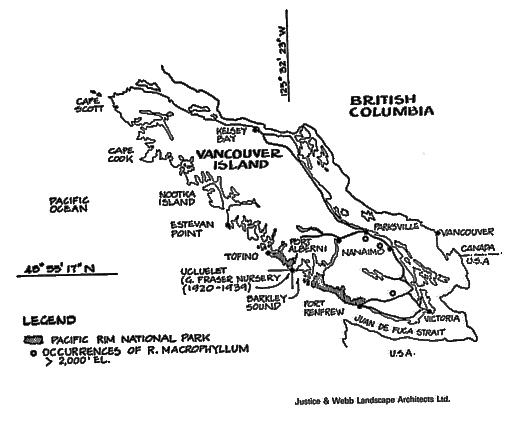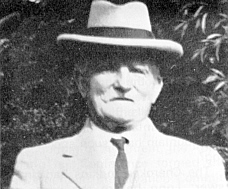QBARS - v30n4 George Fraser 1854-1939
George Fraser 1854-1939
Lillian Hodgson, Vancouver, British Columbia

|
One of the most beautiful sections of the British Columbia coast, inaccessible until recently except by boat or by torturous logging road over the mountains from Port Alberni, is a narrow strip on the rugged west coast of Vancouver Island from Ucluelet to Tofino. Much of this narrow strip is now preserved for all future generations as Pacific Rim Park, Canada's newest national park. However, to local rhododendron enthusiasts, the little village of Ucluelet was also the home of hybridist George Fraser, and the garden Mecca of the many tourist boat excursions that navigated the coastal waters over 50 years ago.
George Fraser was born in Scotland on October 25th, 1854 and as far as we can ascertain died sometime in 1939, but it is almost as difficult to piece together his life as it is to find any remains of the plant studies and hybridizing that completely absorbed his waking hours at Ucluelet.
George Fraser never married, but we gather from his letters to Joseph Gable of Stewartstown, Penn. that he was a very sensitive and affectionate man, devoted to his younger brother and sister and their children. He was also a prolific correspondent who found a kindred soul in the then much younger Joe Gable and was in part responsible for encouraging that fledgling hybridist who later became one of America's foremost authorities. It is from these letters that we must try to preserve a very small part of the work of one particular man that could easily pass into oblivion.

|
| George Fraser at age 80 |
Mr. Fraser was employed as an estate gardener in Britain before immigrating with his sister Maggie to Winnipeg, Manitoba, in 1883. From this period until 1889 he was in partnership with a John G. Thompson in a greenhouse business. It is interesting to note that Mr. Thompson became superintendent of the Victoria, British Columbia parks for 17 years, and later became head gardener for the Vancouver Parks Board for 21 years before becoming superintendent. After spending a short time in Victoria, probably with Mr. Thompson, Mr. Fraser mover to Ucluelet in 1897. Under the ideal conditions for rhododendrons - moist air from the Pacific Ocean and the mild influence of the Japanese Current - he grew such tender species as Rhododendron arboreum and the big leaved R. grande in what was the most northerly area in Canada in which any rhododendrons were being cultivated commercially.
Over the years since his death his collection has been scattered and all that now remain are several plants of R. ponticum in the vicinity of what used to be his home, and a few rhododendrons in the churchyard at Tofino, one of which is a glorious red R. arboreum , 20 feet in height with a crown 20 feet in diameter. The largest branches are up to 8 inches in diameter. Next to the belfry is an extremely large plant of 'Fastuosum Fiore Pleno'. At the peak of his work however his garden was the wonder of many visitors and the source of exchange between himself and enthusiasts throughout the world. Hundreds of his crosses were shared with Joseph Gable and Mr. Magor in England but it is doubtful if any remain in cultivation except in private collections with the exception of the plant that bears his name R. 'Fraseri', and R. 'Albert Close'.

|
|
Probably planted by George Fraser in the late 1920's, the trunks of this
red R. arboreum can be seen in the churchyard at Tofino on the West Coast of Vancouver Island. This rhododendron is now over 25 feet high. Photo by Clive L. Justice |
R. 'Fraseri' is of particular interest to rhododendron collectors because it is reputed to be the only R. canadense cross in existence that is still in cultivation. Frederick Street in his well known book on "Azaleas" published in 1959 states in his chapter on the subseries canadense , "there are no hybrids of this species in cultivation today. Two have been recorded - one raised by Dean Herbert in about 1820 and another which was called 'Fraseri' introduced in 1920 but not now known". It is available in a limited way in the Vancouver, British Columbia area and because plants were sent to the Arnold Arboretum, Joseph Gable, and several collectors in Britain, it is difficult to understand Mr. Street's statement. As far as the flowers are concerned, it can hold its own in any show - I have personally won awards for sprays on every occasion that I have exhibited. For some time there seems to have been some confusion as to the other parent but Mr. Fraser said in one of his letters to Mr. Gable. "We would really be better to use the name of Az. mollis for the deciduous Az. japonica . I can see no difference and in that cross of yours with R. luteum pollen on R. japonicum I don't know whether it is the deciduous or the evergreen azalea that you used. The Arnold Arboretum made out that R. 'Fraseri 'was a cross between rhodora and Az. japonica while as a matter of fact the flower used in crossing was from a mollis from seed sent from Hagge and Enright. Lutea is just another name for pontica. Rhodora of course is just another name for R. canadense . For many years Az. japonica and Az. mollis were considered to be the same and E. H. Wilson in his book "A Monograph of Azaleas" (P. 101, 1921) and quoted in J. G. Millais" "Rhododendrons and their Hybrids and Species'', second series, P. 165166, states: "that in the past it ( R. japonicum ) has been neglected is undoubtedly due to its having been confused with its less hardy Chinese relative ( R. molle ). The nurserymen of Belgium and Holland recognized the two plants as distinct".
R. 'Fraseri' bloomed for the first time in 1919 and was exhibited at the rhododendron show in London, England with great success - its first public appearance. Later it was written up in the Gardener's Chronicle on May 4th, 1935 as being among the exhibits of the Rhododendron Society at its very elite show. R. 'Fraseri' was given its name by the late Wm. Watson, A. L. S., curator of the Royal Botanic Gardens, Kew, England and described by him in the Gardeners Chronicle of 1920, Page 225, and illustrated in the same Journal, Aug. 18, 1923 from a photo by E. H. Wilson, Arnold Arboretum, Harvard University. One interesting observation was made in a letter to Joe Gable dated May 14, 1928 to the effect that R. 'Fraseri' is infertile, but he did notice that at the time of writing there was a little pollen on the stamens and that sometimes the pollen of infertile hybrids is good. This plant should be in every collector's garden not only for its delicate beauty inherited from R. canadense , but also for its unique and rare hybridization. It is stoloniferous and therefore easy to propagate.
Other crosses made by Mr. Fraser involved R. macrophyllum , two of which were named. The first was R. 'Albert Close', using R. macrophyllum (or R. californicum as it was known then) with R. maximum as the seed parent. This cross is erroneously credited to Mr. Joseph Gable in the International Rhododendron Register. Mr. Gable definitely mentions in a letter dated Nov. 8, 1960 and addressed to Mr. Clive Justice of the Vancouver, B.C. Chapter that the cross was made by George Fraser. David Leach in his book gives credit to Fraser with Gable as the one who introduced it. R. 'Albert Close' is the only R. macrophyllum hybrid known to be in cultivation commercially but there is a probability that his second named cross, R. 'George Fraser' is growing in some collector's garden. If so, members in the Vancouver Chapter would appreciate hearing about it.
His various experiments included the crossing of both the Mountain Laurel ( Kalmia laiifolia ) and Labrador Tea ( Ledum groenlandicum ) with rhododendrons and this is of particular interest now that others have tried this and are distributing their efforts commercially. He also crossed the native salmonberry ( Rubus spectabilis ) with the English raspberry, the resulting hybrid having a flower 2 inches in diameter. The fruit however was bitter. His work with plants other than rhododendrons was extensive particularly with selected forms of native species. For instance, he found a drooping Douglas Fir at Alberni on Vancouver Island with needles considerably longer than normal. He shared this with Mr. Gable and others in the hope that further selections would be made from the seedlings.
It is impossible to condense the lifetime work of such a man as George Fraser into a few pages of print - a man who was better known at Kew than locally. Plantsmen today have a tendency to hold in contempt the results of hybridizing that was done 60 years ago when R. ponticum and others in the ponticum subseries were popular parents. No doubt George Fraser and others of his time did use the aristocratic R. arboreum , R. griffithianum and the like, but there was no market commercially because of the tenderness factor. That is why it is so tragic that nothing remains of his private collection that can be traced. However in spite of our more scientific approach to plant breeding we still owe a debt of gratitude to those pioneers who laid the foundation on which we can build.
